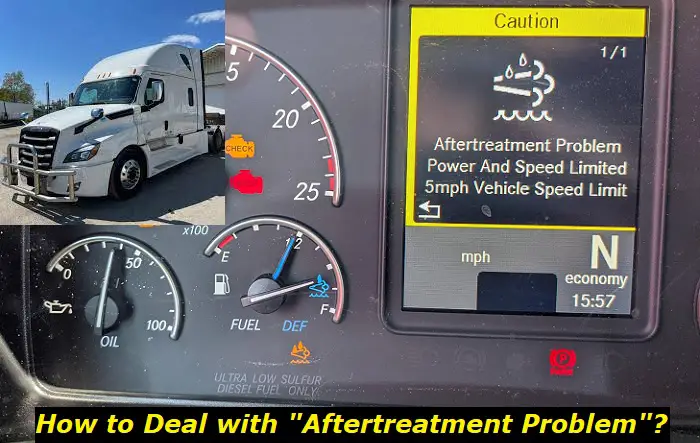Aftertreatment Problem Power and Speed Limited: Preventive Measures
Aftertreatment systems play a vital role in heavy machinery, significantly contributing to emissions control and environmental care. These systems treat exhaust gases to reduce harmful emissions, bringing significant benefits to both the machine's performance and the environment. However, problems in aftertreatment systems can lead to power and speed limitations, severely impacting a machine's operations and efficiency.
Understanding the intricacies of power and speed limitations associated with aftertreatment issues provides the base for this discussion. The primary focus is to elucidate common aftertreatment problems that cause power and speed restrictions in heavy machinery, and how these can be diagnosed and resolved. This knowledge is essential for mechanics and operators in order to keep heavy machinery running at optimal performance.

Understanding Power and Speed Limitations Due to Aftertreatment Issues
Whether you're operating an earthmover, a bulldozer, or a crane, the power and speed of your heavy machinery are central to your operations. Nearly every task depends on the machine's ability to deliver the necessary power and achieve the right speed. However, issues with aftertreatment systems can lead to significant limitations in these areas.
Aftertreatment systems interact intimately with the engine, treating the exhaust gases to limit the release of harmful emissions. A well-functioning aftertreatment system allows the engine to perform at its best while reducing its environmental impact. However, problems in this system can interfere with the engine's performance, leading to limitations in both power and speed.
Power and speed limitations due to aftertreatment issues often arise when there's an accumulation of particulate matter or when the system can't adequately treat the exhaust. For instance, if there's a blockage in the Diesel Particulate Filter (DPF), it can affect the outflow of exhaust gases. This resistance forces the engine to work harder, affecting its power output. Similarly, if the Selective Catalytic Reduction (SCR) system isn't functioning correctly, it can result in Derate, where the engine's power is cut down to prevent severe damage.
Moreover, most modern heavy machinery comes with built-in measures to limit power and speed when it detects a problem with the aftertreatment system. This primarily serves as a protective mechanism, intending to prevent further damage before repair or maintenance can be carried out.
Grasping how aftertreatment systems can induce power and speed limitations is vital in diagnosing and resolving these issues. It permits us to understand the crucial role these systems play in determining the overall performance of our machinery and reflects the need for their proper maintenance.
Common Aftertreatment Problems Affecting Power and Speed
So let's get down to the nitty-gritty of common problems that affect power and speed by meddling with aftertreatment systems in heavy machinery. If something is going awry here, your machine's performance can take a considerable beating, and as someone who's worked around these mechanical beasts, I know that troubleshooting is never a one-size-fits-all endeavor.
One issue to keep a keen eye on is excessive soot levels. Soot is a byproduct of the combustion process. When there's too much of it in the Diesel Particulate Filter (DPF), it can cause a blockage leading to increased back pressure, reduced power, and slow speeds.
Active regeneration interruption is another common problem. Regeneration is a process that burns off accumulated soot in the DPF at high temperatures. If the requisites for initiating automatic or 'active' regeneration aren't met - these typically involve operating speed or load conditions - then it can get interrupted. This interruption can lead to soot build-up, resulting in the same blocked DPF and hence power and speed reductions.
Then there's the issue of malfunctioning sensors. Your machinery's sensors play a vital role in monitoring and managing the aftertreatment process. Faulty sensors can cause a string of problems, including inaccurate soot load readings, triggering false alarms, or hindering DPF regeneration. As you might've guessed it, any of these could directly limit your machine's power and speed.
Lastly, let's talk about system leaks. A leak in the aftertreatment system, be it in the DPF, Selective Catalytic Reduction (SCR) system, or Exhaust Gas Recirculation (EGR) system, disrupts the aftertreatment process. This disruption can cause the machine to limit its power output as a safety measure, inevitably leading to lower speeds.
Addressing these issues promptly and with the level of attention they deserve will help ensure the uptime of your equipment, and of course, secure peak performance. Keep your mind peeled for these potential headaches and remember, prevention is always better than cure.
Maintenance Tips for Overcoming Power and Speed Limitations
Now that we've established how aftertreatment limitations can hamper a machine's performance, let's direct our focus to preventative care and maintenance. Fine-tuning and regular upkeep of your heavy machinery can be invaluable in preventing and resolving aftertreatment problems before they escalate.
Stay diligent with preventative maintenance: The foundation for keeping your machinery in top shape is regular preventative maintenance. Scheduling consistent services for your machine ensures that any potential issues can be nipped in the bud. It's worth the time investment to keep records of servicing and checks for oil changes, filter replacements, and coolant level inspections, among others.
Get specialist advice: Involving an expert on machinery aftertreatment systems can be a game-changer in maintaining your equipment optimally. These professionals have a wealth of knowledge and experience in diagnosing and solving aftertreatment issues and can provide you with custom advice for your specific machine model.
Periodic checks of aftertreatment component: It is paramount to do frequent checks on the key aftertreatment components such as Diesel Oxidation Catalyst (DOC), Diesel Particulate Filters (DPF), and Selective Catalytic Reduction (SCR) units. Catching any faults early can help prevent costly repair and replacement further down the line.
Remember the golden rule: Proactive maintenance always triumphs over reactive maintenance. Keep your aftertreatment systems in mind as part of your machine's overall health. By doing so, you'll maintain the power and speed capacities of your heavy machinery, ensuring reliable and efficient performance.
Case Studies: Real-World Scenarios of Aftertreatment Problems
Let's move onto some concrete scenarios where aftertreatment problems led to limitations in power and speed in heavy machinery. Looking at these instances will provide a real-world understanding of these issues and their solutions.
In the first scenario, we encountered a heavy-duty truck experiencing significant loss of power. The driver highlighted that the truck had slowed down considerably, even on flat surfaces. Upon inspection, we realized that the Diesel Particulate Filter (DPF) of the aftertreatment system was completely saturated, hindering exhaust gas flow and causing the power reduction. This saturation occurred due to infrequent regeneration of the filter, a process which burns off the accumulated particulates. Through an active regenerative process guided by the Electronic Control Module (ECM), we were able to restore the truck to its optimal power levels.
In another case, a power generator faced frequent and random slow downs. It turned out that soot deposits on the Diesel Oxidation Catalyst (DOC) were causing the sporadic power dips. After employing a professional cleaning service that used a high-powered air blower to remove the soot, the generator's power supply returned to its steady state.
In a third instance, a construction excavator experienced diminished power and slower dig speeds. Here, the culprit was an underperforming Selective Catalytic Reduction (SCR) system in the aftertreatment. It was found that the SCR catalyst was not converting enough NOx emissions due to a lack of Diesel Exhaust Fluid (DEF). The deficiency was because of a leak in the DEF supply line. The solution was twofold: repair of the leaking DEF supply line and a system reset once the DEF tank was refilled. The excavator then resumed its previous power and speed performance.
These scenarios underline the fact that various factors within the aftertreatment system can lead to power and speed limitations in heavy machinery, but with the appropriate interventions, these problems can be successfully resolved.

Add comment